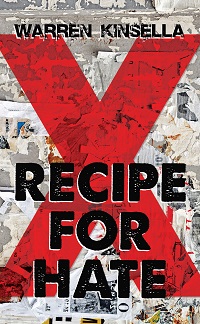| ________________
CM . . . . Volume XXIV Number 22. . . . February 9, 2018
excerpt:
Recipe for Hate opens with a grizzly, crucifixion style murder outside a seedy bar in Portland, Maine. The murder victim is Jimmy Cleary, a teen aged punk rocker whose band has just finished its set in the bar. This shocking act catapults Jimmy’s friends, led by narrator Kurt Blank, into a violent mystery that gives readers front row seats on the punk rock scene of the late 1970s and stretches into the ugly, hate filled world of white supremacy. Punk rock culture is almost a character, itself, in this novel. As one murder turns into two and then Kurt’s best friend X is attacked, it becomes clear that this new youth subculture is the real target. But who are its enemies? Well, almost everyone it seems. At school Kurt and his friends are known as the X Gang. They are isolated by both staff and students, but that’s just fine for this group of misfits who feel disdain for everyone else anyway. Kurt tells readers, “To the high school’s ruling classes, we were ‘fags’, ‘geeks’, and losers…They’re lemmings…It’s a single brain they all share so that they all do, and say, and believe, the same things, always.” The group’s leader and philosophical guru is Christopher X, a brilliant but inscrutable young man whom Kurt deeply admires. Kinsella devotes a chapter to detailing X’s history and philosophy, a kind of manifesto of his version of the punk rock movement. Readers get insight into X’s personality via anecdotes like this where X explains to the track coach that, despite his talent, he doesn’t want to be on the team because they don’t do javelin. X tells him, “Animals can run faster than us, and jump higher than us…I want to do something an animal can’t do”. Kurt, himself, is a very dark character. He is a closeted homosexual whose angry, troubled upbringing has left him depressed and alienated. Kurt’s description of his hometown is typical of the novel’s narrative tone: “As Portland grew…it attracted more yuppie douchebags.” A lot of Kurt’s narration is focused on the history of Portland as it relates to the punk rock movement. Kurt wants to be a writer, and this novel, it turns out, is his account of the clash between the punk rockers of the Left and the neo Nazis of the alt Right. Kurt has found community, inspiration, and also respect for his music in this tight circle of punk loving teens. The X Gang includes a couple of other punk rock bands, like Patti and Betty Upchuck, members of a feminist band called the Punk Rock Virgins. Only Kurt knows that Patti is a sexual assault survivor. Both X and Kurt write and contribute to an unofficial school newspaper that explores and discusses punk rock values, history, and influences. Along with Kurt’s long interior monologues, the newspaper and other narrative devices allow author Warren Kinsella to showcase his extensive knowledge and passion for punk rock. However, these long passages often slip into an expository style that may only appeal to readers with a special interest in punk rock. With the murder of a second member of the X Gang comes the wrath of parents, and special attention by the school, local media and, of course, the police. The gang’s punk rock persona links them to the wild antics of British bands like The Sex Pistols and Kurt’s personal favourite, The Clash. Soon, the gang is barred from playing, even in their beloved Gary’s, “the temple of filth”. This spurs the gang to organize a festival of punk rock bands to raise money for a reward to “catch the bastards that killed Jimmy and Marky”. The gig is massively successful, galvanizing punk rockers from as far away as Montreal and Boston. Kinsella spares no detail in describing the concert, which again may interest the keen music lover but does compromise the story’s momentum. During the concert, X is seriously assaulted, and the police are forced to shift their theory. Clearly X and his friends are victims, not perpetrators. An arrest is finally made, and an alt Right connection to the murders emerges thanks to X’s sharp thinking and observation. While X’s ability to connect the dots as the police bungle the case does strain readers’ sense of the credible, the pace of the novel picks up. Readers are rushed from the inside of a courtroom to a Clash concert, to an anti racism rally, to a final violent confrontation with Neo Nazis in rural New England, and a pretty satisfying conclusion. It is not surprising to learn from the “Dear Reader” letter at the beginning of the book that Canadian author Warren Kinsella has a personal connection to the events that form the context of the novel. Readers who sustain interest through the long narrative sections based on Kinsella’s insider knowledge will be rewarded with a complex, multilayered mystery that highlights the energy and passion of youth while pointing a finger at issues like police misconduct, irresponsible journalism and the rise of the alt Right. Highly Recommended. Charlotte Duggan is a teacher librarian in Winnipeg, MB.
Next Review |
Table of Contents for This Issue
- February 9, 2018. |
